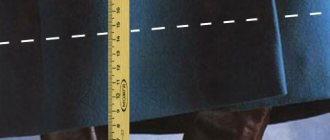Every housewife has managed to burn fabric while ironing at least once in her life. This often happens due to inexperience or carelessness. If the item has not lost its functionality, you can try to correct the situation.
There are many effective methods to help remove iron stains. Even a hole can be easily dealt with if you use your imagination. Now let's figure out what to do if you burn your clothes while ironing, and how to avoid this in the future.
Sealing leather products
Despite the high quality of such outerwear, it is also subject to some damage that can be disguised at home. Most often in this case, universal glue “Moment” is used.
If the damaged area is on the sleeve, then you need to turn the jacket inside out and tear off the lining a little. The jacket should be straightened in order to correctly cut a small piece of fabric, the diameter of which will correspond to the existing hole. Fixing glue must be applied both to the patch itself and to the defect site. The adhesive composition should be fixed (this procedure takes no more than 30 minutes).
We turn on natural ingenuity
Don’t worry about inept handling of a cigarette and throw your favorite down jacket in the trash. Everything can and should be fixed. Of course, the easiest step is to go to the nearest workshop for repairing and sewing outerwear. But you can also make your own efforts, breathing new life into a seemingly irretrievably damaged thing. Warm jackets are mainly made from bologna. This material quickly rose to the top of popularity in the middle of the last century and is still among the favorites. At its core, bologna is nylon that has been treated with a special polymer composition containing acrylic additives. It is thanks to this impregnation that jackets and down jackets made from Bologna reliably protect a person from cold, dampness and winds.
But such material is extremely difficult to repair. If fixing a hole on a down jacket made of ordinary fabric is not difficult at all and only requires certain seamstress skills, then with bologna things are more complicated. This material is extremely difficult to sew and the end result will be unsightly and noticeable. A different approach is needed here.
How to repair a cut
A cut is considered the most harmless damage to clothing. It can be glued or sewn. To sew up a hole, use a hand or machine stitch called a zigzag stitch. But this can only be done if the damage is in an inconspicuous place and you have suitable threads.
You can sew the cut by hand in the following way:
- Thread the thread through the needle, leaving one end longer than the other.
- Tie a knot at the long end of the thread.
- Insert a needle into the end of the cut from the inside.
- Make several transverse stitches at a minimum distance from each other.
- Place small stitches next to each other and sew up the main part of the damage.
- Having reached the end of the hole, make several stitches the same as at the very beginning.
- Fasten the thread and hide its end under the stitches.
If you have a sewing machine, use a zigzag stitch, bringing the thread to the wrong side.
If the damage has occurred in a noticeable place and the only way to repair it is to sew it up, make a similar seam on the opposite side for symmetry.
If the cut cannot be stitched, it can be taped. For this:
- Cut a long piece of similar fabric 1 cm longer than the cut.
- Spread the front side of the shred with glue.
- Insert the strip into the cut, carefully straightening it. For convenience, you can use tweezers.
- Align opposite edges of the cut.
- Press the details.
We update the down jacket ourselves
If you carefully repair the damaged area, not a trace will be visible.
If a torn hole appears, you can not only sew everything up or apply a patch. Various types of applications are popular now. You can use this. Thus, you can not only get rid of the hole, but also update your down jacket.
Before mending a tear, you should visit the appropriate store to select a decal or pattern. A similar method can be used if the sleeve or main part of the jacket is torn.
Iron-on adhesives and applications
Appliques and stickers can help out in many cases, but this method has a drawback. You can sew on a pattern or stick on a beautiful picture only where it is appropriate, namely:
In other cases, the stickers will look stupid, which means it’s best to consider another way to fix the holes. If embroidery was chosen, it should be done on a separate fabric, which will subsequently be sewn to the torn area of the jacket.
Braid or tape
You can disguise the hole next to the seam using tape. Many people are interested in the question of how to fix a hole in a jacket so that it is invisible and also beautiful. It's simple, you should use all your imagination. It doesn’t matter what length or color the braid is. Don't be afraid to experiment.
Another way to disguise a hole is with reflective tape. The advantage of this method is that it will not only hide the defect, but will also make the jacket visible at night. You need to cut a piece of tape and carefully stick it over the gap.
How to sew regular fabric patches
A fabric patch will help to disguise a burnt hole on a jacket. To work you will need:
- threads to match the jacket;
- scissors;
- a piece of fabric;
- sewing machine.
Technique for sewing patches:
- from the inside out, rip the lining along the seam next to the hole;
- 2 identical parts are cut out from a flap suitable in texture, color and density;
- the hole is covered with patches on the front and back sides;
- fix the parts with pins;
- stepping back 2 mm from the edge, stitch it on a machine;
- At the final stage, the lining is sewn together.
To prevent the patch from sticking out, use only soft materials. Raincoat fabric would be an ideal option.
If a sewing machine is not available, jacket repairs are performed manually. The patch is sewn on with a hidden or stem stitch. In the second case, it is recommended to use bright threads. Then the stitching will look more like a decorative finish.
Repair with application
You can use another method to help solve the problem of how to repair a cigarette hole on a jacket. This is to decorate clothes with applique. But here it is worth paying attention to the style of the clothing itself . After all, everything should be in harmony and correspond. Therefore, you will have to work hard to find suitable thermal decals (they are sold in craft supplies).
When choosing a thermal sticker, you should take into account the style and style of outerwear. If a hole from a cigarette has formed on the sleeve, you can use two applications to make the jacket look harmonious.
If the clothes already have rivets, then you can additionally use these accessories. In addition to the application you will need:
- Iron.
- Gauze.
- A piece of fabric slightly larger than the size of the burnt hole, but smaller than the decal itself.
When choosing a thermal adhesive, you should take into account that it matches the style of the jacket.
Working with a thermal adhesive is carried out in the following steps:
- We trim the lining and place on the wrong side of the garment (in the area of the hole) a piece of fabric of the same color.
- We sew a back patch along the edges so that there is no hole (otherwise the appliqué will have nothing to attach to).
- We put the applique on top of the hole (on the front side) (after removing the protective film from its backside).
- Cover it with damp gauze and iron this area for 10–15 seconds.
- Then you should iron this section of the fabric, but from the inside out, so that the thermal appliqué grips more firmly.
- After cooling, the burnt jacket is renewed.
When choosing a repair using such a sticker, it is worth remembering that it will only look appropriate on sleeves, pockets and chest . If a cigarette burns a piece of fabric in another place, it is better not to use the applique - it will look ugly.
How to seal a hole
If your jacket is torn and you don’t want to bother with sewing, you can seal it. To repair a burnt hole or cut you will need:
- glue (KP-1 or Moment);
- cotton pads;
- wooden spatula;
- iron;
- degreaser (acetone, alcohol, gasoline);
- patch.
How to seal a bologna jacket:
- the jacket is turned inside out;
- the lining is ripped open;
- degrease the cut or hole;
- glue is applied to the patch;
- gauze is placed on the inside;
- a patch is applied to the front part;
- cover with unnecessary cloth;
- A cold iron or any other weight is placed on top.
If a hole appears on a sports jacket, glue on a themed patch or chevron.
Repairs are carried out in a quiet environment in a ventilated room. The glue is applied in a thin layer so that it does not subsequently leak out from under the edges of the patch.
Useful tips
A few simple recommendations will help you get the job done right.
- When gluing a patch, it is better to use tweezers for more comfortable work.
- It is necessary to use only transparent and waterproof glue suitable for working with fabric materials.
- When correcting a patch with uneven edges, it is recommended to first trim the edges to make them smooth.
- When using stickers and appliqués, you must first sew up the scorch mark. This will help prevent the fabric from unraveling in the future.
- You can use a sewing machine to sew a zigzag seam.
- It is recommended to select applications and stickers in accordance with the style of the product. For a classic down jacket - flowers or bright designs, for sports models - badges or symbols of popular youth brands.
Features of the material
Bologna is a synthetic fabric that consists of a dense weave of polymer threads. It is smooth to the touch, thin and airtight. Often used to produce waterproof clothing.
Bologna jackets are popular because the material has the following properties:
- lasting;
- easy;
- does not wrinkle;
- practical;
- does not get wet;
- resistant to acids, alkalis, mold;
- it's easy to take care of.
Such jackets protect from wind and rain, but are very fragile. Any sharp object can leave cuts on the surface; holes also appear from exposure to high temperature. Therefore, the problem of how to seal a Bologna jacket is familiar to many. There are several simple ways to do this without being noticed.
Causes of iron stains
They arise from improper handling of an electrical appliance. The iron, which is turned on for a long time, overheats and leaves stains when it comes into contact with the fabric. Modern devices are equipped with a regulator, so when ironing you should take into account the type of fabric and set the desired temperature. The power of the device also matters. If it is small, then the iron heats up slowly. When power consumption is high, this happens in a matter of minutes.
Burnt stains most often appear on fabrics that contain synthetic fibers. They often remain on items made of wool and silk. Cotton and linen are ironed at high iron temperatures and therefore rarely develop brown marks.
Every housewife should remember:
- clothes should be ironed from the wrong side;
- It is advisable to place gauze or a special pad on the fabric;
- It is necessary to monitor the serviceability of the iron and the cleanliness of its soles.
To avoid problems, you can use steamers, but this device also requires careful handling, attentiveness and responsibility.
How to fix a hole in a bologna jacket
Bologna is a synthetic material from which raincoats, down jackets, jackets and sports waterproof clothing are most often sewn. The fabric consists of nylon or nylon, coated with a water-repellent material - silicone or polyacrylate. It is 2 times stronger than cotton fabric.
Bologna is not afraid of water, acids and alkalis. But if you accidentally catch your sleeve on something sharp, a hole will appear on the jacket. Methods for repairing outerwear depend on:
- localization of the defect;
- hole size;
- jacket colors;
- product design.
The most difficult thing to deal with is holes in classic-cut jackets made from light-colored jacket fabric. A hand-darned hole will be visible, and a patch in the shape of an animal or a sports patch will catch the eye. But there is a way out of this situation. Manufacturers of fabrics and accessories produce a variety of finishing materials for clothing that perfectly mask holes in jackets.
If there is a tear along the seam
If a hole appears on the seam, it needs to be sewn up by selecting the desired color of thread. In the absence of a sewing machine, the jacket is repaired manually.
Repair features:
- select a thread that matches the color of the jacket fabric;
- turn the jacket inside out and place it on the table;
- in the area of the hole on the wrong side, rip out the lining;
- Having folded the parts at the tear site, sew the fabric with a stem stitch.
During work, they try to get into the holes from the broken factory seam. After filling the hole on the front side of the jacket, the lining is sewn together.
If you don't want to bother with the lining, then sew the jacket with a hidden seam:
- from the inside out, a needle is inserted into the tear site;
- from the front side, two parts of bologna are pulled together with parallel stitches;
- at the end, the thread is taken out from the wrong side and a tack is made so that the seam does not come apart.
Gaps in the area of internal and patch pockets are perfectly masked with decorative braid or trim. The seam will be neat only if the distance between the stitches is the same. To avoid handicraft repairs, you should use a sewing machine.
How to disguise under zipper
If desired, the hole in the jacket can be closed with a zipper. If the defect appears on the front of the product on the right, for symmetry, make the same insert on the left. Repair using a zipper will not only get rid of the problem, but will also make the jacket look original.
DIY jacket repair technique:
- sew up the hole by hand;
- Use tailor's pins to secure the zipper at the top;
- Sew around the perimeter using a machine, choosing a thread of the desired color.
If you don’t have a sewing machine, but you don’t want to bother with hand sewing, then use rivets - rivets.
The simplest models consist of a flat metal cap and a stem-shaped counterpart. To make the insert in place of the hole look original, purchase decorative rivets with multi-colored stones.
Braid, applique or ribbon as a patch
If a bolognese jacket has defects in the form of scratches or holes, sewing accessories will help correct the situation. The following are used as patches:
- Braid is a narrow woven or fabric strip that is used for decorative finishing and repair of clothing. It can be used to decorate scratches or cuts, and strengthen seams on the front or back side of the jacket. Differs from decorative tape in increased strength. The braid is made of cotton, linen or wool.
- Appliques are decorative elements made from scraps of fabric, adhesive interlining, decorative buttons, rhinestones, etc. This method of repairing jackets is suitable for creative people who can create entire compositions from pieces of different materials.
- Bias binding is a fabric strip cut on a bias, which is used for edging parts. Suitable for filling holes in the hem area of a sleeve. To prevent the trim from being noticeable, the trim is sewn onto both sleeves at once.
- Chevrons and stripes are decorative elements intended for finishing or repairing clothing. For those who have never held a needle in their hands, adhesive-based fabric patches are suitable. In fabric and accessories sales centers you can purchase original patches in the form of cartoon characters, motivational inscriptions, patriotic symbols, etc.
To disguise holes on bolognese jackets, decorative buttons, reflective stripes, and stripes with sequins are additionally used.
How to make a patch on a jacket in 5 minutes:
- sew the hole manually with thread of any color;
- attach the adhesive-based patch;
- Place gauze or cotton cloth folded in several layers on top;
- place a heated iron on top for 25-30 seconds.
Under the influence of high temperature, the hot-melt adhesive will become liquid and absorb into the jacket fabric. This patch holds tightly and does not come off even after machine washing.
Additional pocket
To cover large defects on the front of the jacket, make a decorative patch pocket. To make the work neat and the decorative insert pleasing to the eye, use a sewing machine.
Making a patch pocket:
- cut out a template from cardboard, taking into account folding allowances (plus 5 mm around the perimeter);
- attach the template to a piece of fabric and trace along the contour with chalk or soap;
- bend 5 mm around the perimeter and iron;
- stitch on a machine, leaving 3 mm from the edge.
Decorating a defect on a Bolognese product with a patch pocket:
- spread the lining over the hole and spread it apart, temporarily securing it with thread;
- attach a pocket on the front side and secure it with tailor's pins;
- Stitch the insert along the very edge using a sewing machine;
- Open the temporary seams on the lining and sew it by hand or by machine.
If you do not have the fabric from which the jacket is made, use other materials (felt, denim) or buy half a meter of raincoat in the store.
How to make a blind seam
Having mastered the technique of applying a hidden seam, you will be able to save many items from your wardrobe. To repair the jacket you will need:
- tailor's pins;
- threads to match bologna;
- scissors;
- a needle with a small eye.
How to sew a hole in a jacket with a blind stitch:
- find a hole in the seam;
- fold the two halves of the fabric and pin them together;
- from the front side, pierce both parts with a needle at the border of the bend;
- bring the needle out on the curved part of one of the halves;
- pierce both parts of the jacket fabric with the needle again, departing 1.5 mm from the previous stitch;
- At the end of the seam, bring the needle out from the wrong side and make a tack.
To hide a hole with a hidden seam, it is not necessary to rip the lining. Therefore, repairing your jacket will take you no more than 10-15 minutes.
How to sew regular fabric patches
A fabric patch will help to disguise a burnt hole on a jacket. To work you will need:
- threads to match the jacket;
- scissors;
- a piece of fabric;
- sewing machine.
Technique for sewing patches:
- from the inside out, rip the lining along the seam next to the hole;
- 2 identical parts are cut out from a flap suitable in texture, color and density;
- the hole is covered with patches on the front and back sides;
- fix the parts with pins;
- stepping back 2 mm from the edge, stitch it on a machine;
- At the final stage, the lining is sewn together.
To prevent the patch from sticking out, use only soft materials. Raincoat fabric would be an ideal option.
If a sewing machine is not available, jacket repairs are performed manually. The patch is sewn on with a hidden or stem stitch. In the second case, it is recommended to use bright threads. Then the stitching will look more like a decorative finish.
How to seal a hole
If your jacket is torn and you don’t want to bother with sewing, you can seal it. To repair a burnt hole or cut you will need:
- glue (KP-1 or Moment);
- cotton pads;
- wooden spatula;
- iron;
- degreaser (acetone, alcohol, gasoline);
- patch.
How to seal a bologna jacket:
- the jacket is turned inside out;
- the lining is ripped open;
- degrease the cut or hole;
- glue is applied to the patch;
- gauze is placed on the inside;
- a patch is applied to the front part;
- cover with unnecessary cloth;
- A cold iron or any other weight is placed on top.
If a hole appears on a sports jacket, glue on a themed patch or chevron.
Repairs are carried out in a quiet environment in a ventilated room. The glue is applied in a thin layer so that it does not subsequently leak out from under the edges of the patch.
Polyethylene or non-woven fabric
Polyethylene or non-woven fabric will help to disguise the cigarette hole. For repairs, you will additionally need a patch or piece of fabric that matches the color and texture of the bologna.
How to seal a bolone jacket at home:
- the jacket is laid out on the table;
- the lining is cut at the site of the defect;
- interlining is applied from the front part to the hole;
- a fabric patch of the same size is placed on top;
- cover with a cotton cloth and press the heated iron for 15-20 seconds.
If you wish, you can repair a bologna jacket with non-woven fabric based on hot-melt adhesive. It is glued using the same principle as fabric stripes.
To ensure that the hole is sealed, the interlining is cut so that it overlaps the edge of the hole by at least 7-10 mm.
Decor will hide stains
Did you put a mark on your jacket with an iron, and nothing can be removed? Don't despair, the situation can be improved. To do this, use a ready-made application. Choose a suitable color and shape and simply iron it to the product. On the reverse side there is an adhesive base that melts under the influence of temperature and adheres to the fibers of the fabric or threads if the item is knitted.
The hole from the iron on the pants can be repaired with a decorative patch. It can be cut from denim and stretched out transverse threads along the edges. You can sew beads, beads, and sequins inside the patch.
A damaged T-shirt will find new life after iron marks appear on it. Apply the pattern to the area and the stains will no longer be noticeable. To do this, we recommend using textile paints.
There is no need to throw away your jacket if a burnt area accidentally appears on it. This is probably the most common case in the practice of housewives. Raincoat material melts to holes under the influence of high temperature.
You can seal them in several ways:
- take it to the studio to have the inserts made. They can be made symmetrical, this will quietly hide the defect;
- glue the applique, and you can choose it for any gender and age;
- do embroidery;
- perform decorative stitches;
- sew on the braid.
As you can see, you can also deal with burnt spots if you show imagination and creativity. It often happens that after alterations you begin to like the clothes even more. Don't despair, it's better to start looking for a suitable solution!
Rules of care
Once you have succeeded in sewing up your Bolognese jacket, you need to take proper care of it so that it lasts as long as possible. The main rule remains that before washing and other procedures you must study all the recommendations on the label. To prevent the jacket from losing its shape, it is best to wash it by hand. In this case, it is advisable to abandon diligent twisting, squeezing and ironing. For routine clothing care, it is best to use warm water (up to +40˚C).
Specialized detergent compositions, as well as care products for synthetics, have a gentle effect. To remove all stains, the jacket can be soaked in a pre-diluted product for 45 minutes (it all depends on the degree and nature of the dirt). The surface of the material can be rubbed with a sponge or brush, but it must not be rubbed. Particular attention should be paid to the most problematic areas - the collar, pockets and elbows. After washing, the jacket must be rinsed in cold water at least three times.
To prevent the jacket's filling from bunching up into separate bundles, it cannot be washed in a washing machine. Indeed, in this case, there is a high probability that creases and folds will appear on the surface of the item, which are very difficult to eliminate. In rare cases, you can resort to the help of technology, but you need to choose a delicate mode.
After washing, do not wring out outer clothing, but allow it to drain over a bathtub or basin. For gradual drying, it is better to choose a well-ventilated room, but away from direct sunlight and electrical appliances. A small jacket can be hung on hangers, but large items based on synthetic padding are best laid out on a clean terry towel, allowing them to dry in a horizontal position.
Updating outerwear
When something is torn, not everyone can make patches for a jacket with their own hands. But this does not mean that you need to run to the first studio you come across. You can fix the problem using various applications, thermal stickers, braid or tape.
If you have singed a sleeve, pocket or chest area, you can cover the jacket with a beautiful picture. To glue an applique or iron-on sticker, you will need a hot iron.
You can mask the hole located next to the seam with braid. This method is good because it is not necessary to match the part to the color of the down jacket. It is enough to show your imagination.
You can close the cut using reflective tape. The advantage of this method is not only hiding the defect, but also creating good visibility at night.
Cigarette marks on clothes
What should we do if we left a burn mark from a cigarette on our clothes?
- You can try to remove a fresh ash burn with onions. Grate the onion until a paste forms. Apply to the scorched area. It is better to leave the mixture on the fabric (for a while). After that, soak the item in cold water, and only then wash it at the temperature required for this material.
- Not very badly burned areas of clothing can be removed by soaking in milk (yogurt). After soaking for several hours, wash the item with regular hand washing with detergent.
If you just can’t get rid of this bad habit, at least be careful when smoking. After all, your life is much more valuable than this pointless activity of inhaling smoke. Which, moreover, harms not only you, but also everyone around you. Including your children!










